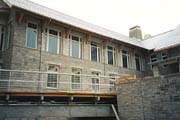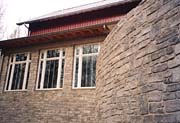
The U.S. Fish and Wildlife Service National Conservation Training Center in Shepherdstown, WV, is a training and education facility for the conservation of fish, wildlife, plants and their habitats. The building is located approximately 75 miles outside of Washington, DC, where it remains a welcoming and neutral place where organizations and corporations can collaborate.
The building was constructed with Seneca Limestone[r], a gray limestone supplied by Rolling Rock Building Stone Inc. of Boyertown, PA. Keeping the building in tune with the surrounding environment was a primary goal for
the architects at SmithGroup in Washington, DC, and the stone played a role in achieving this objective. The tone of the limestone reflects the building's natural West Virginia setting.
“The Fish and Wildlife Service was very interested in using native materials,†said Design Principal Maynard Ball of SmithGroup. “We went through a lot of local reps until we found a couple that we liked. We then went and visited the quarries.â€
The architect was interested in using a fieldstone quarried on the premises that an old stone house on the site was created from, but it was unavailable, according to the architect. “We chose some thing that looks similar. The important issue was having something that was a natural material that was well-crafted and made a statement about the quality of the place as well as fit in with the natural setting.â€
The final choice, Seneca Limestone, quarried in the New Hope area of Pennsylvania, seemed to satisfy each element for the structure. “It was a very close match to the indigenous limestone used in the local area,†explained Terrence Meck of Rolling Rock Building Stone Inc. “The architects wanted it to be an appropriate stone for the location, and they wanted an ashlar building stone. They wanted stone that worked well in the local region, and we knew what types of products to offer.â€
A total of 1,850 tons of Seneca Limestone was used to complete the building, and it was installed in a random ashlar pattern. “The random ashlar stone was cut on hydraulic splitters -- also known as a guillotines -- with a bed thickness of 4 to 6 inches, heights ranging between 3 and 12 inches and lengths ranging between 6 and 24 inches,†said Meck.
Over the course of the project, great care was taken to make sure everything went on schedule, even though the various parties were based in scattered locations in the Northeast. “We met the mason contractor's schedule from hundreds of miles away, during all seasons and weather conditions,†explained Meck. “Logistics is a major portion of what a customer needs, and this quantity requires the quarry and mason contractor, as well as general contractor, to understand one another and the facts surrounding rubble stone quarrying and logistics. We managed supplying this project nearly problem free regardless of the obstacles.
FRANCO of Pittsburg, PA, executed the installation of the project with a standard rubble stone masonry installation, according to Meck.

U.S. Fish and Wildlife Service National Conservation Training Center, Shepherdstown, WV
Architect: SmithGroup, Washington, DC
Stone Supplier: Rolling Rock Building Stone Inc., Boyertown, PA
Stone Installer: FRANCO, Pittsburgh, PA